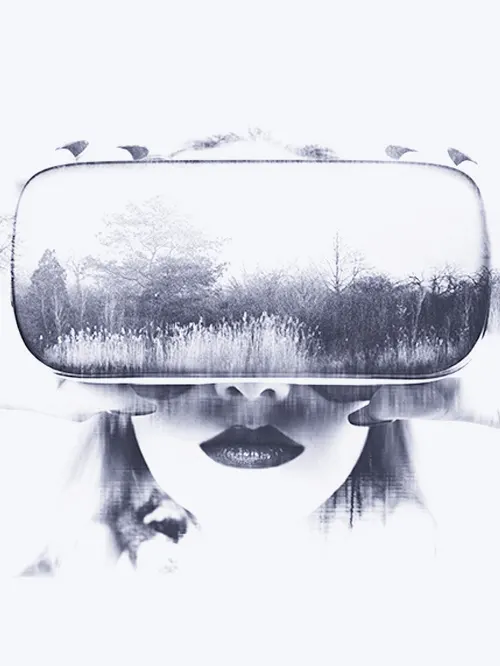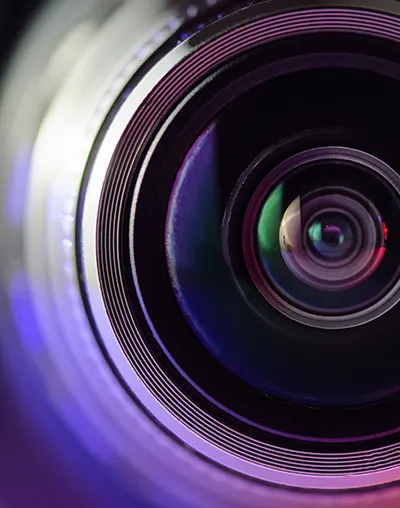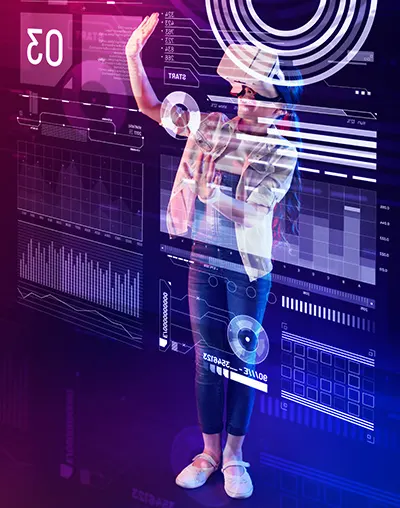
Virtual reality and augmented reality
Discover what each of the Augmented Reality and the Virtual Reality looks like…


Virtual Reality
VR is a technology that plunges a person into a digitally created world.

Augmented Reality
It is the superimposition of reality and elements calculated in real time.

Mixed reality
It is the result of the fusion between the physical and digital worlds.

What is Virtual Reality?
Virtual reality (VR) is a technology that allows people to immerse themselves in a digitally created artificial world. It should not be confused with Augmented Reality (see our dossier on Augmented Reality and its applications).
It can be a reproduction of the real world or a totally imaginary world. The experience is at the same time visual, auditory and, in some cases, haptic with the production of feedback effects. When the person is equipped with the appropriate interfaces, such as gloves or clothing, he or she may then experience certain sensations related to touch or certain actions (blow, impact, etc.). More details about technologies on businessinformationtechnology.net.

VR as a professional tool
It is now also the professional world that adopts the immersive VR headsets. The maturity of this cross-technology with the advent of experiential marketing has therefore propelled VR through different professional sectors that we will look at.

VR in the museums
Museums and places of cultural interest, many og them are beginning to use immersive virtual reality to offer other ways to visit or discover inaccessible places. These have the advantage of integrating scripted content: films, 3D reconstructions, etc.

VR and events
Another sector impacted by VR: the event industry. Indeed, it became obvious for many brands that it was necessary to take advantage of VR to promote events. More and more presentations of products and services are made through VR.
Virtual Reality essentials
VR headset
Swivel chair
VR controllers
VR Cover
VR gloves
Which VR headsets are the best ?
The Oculus Rift
First “new generation” VR headset for the general public. It is a wired helmet connected to a computer with a good display quality. Controllers are also available to interact with the virtual environment displayed in the headset.
The HTC Vive
A direct competitor of the Occulus, the HTC vive is also a wired headset (soon available in non-wired) connected to a PC. It also has joysticks and requires the installation of two sensors in order to track the user in space.
The Samsung Gear VR
Autonomous and connected to the Samsung smartphone, it is obviously less powerful than the two models presented above. It is however much less bulky and still delivers a good immersive experience. You can get more information on effitech.fr.
Augmented Reality, what is it?
Augmented Reality (or AR) is a technology that allows the integration of virtual 3D elements (in real time) into a real environment. The principle is to combine the virtual and the real and give the illusion of perfect integration to the user. More on energietechnology.com.

Capturing the environment
Lots of sensors can be used: GPS, camera, accelerometer, hygrometer, hydrometer,…

Understand the environment
A computer to understand the environment and make the right mix with the virtual elements.

A platform
An Augmented Reality platform to show the user the result of the combination related to the environment.
AR techniques
There are several techniques to make augmented reality. The essence of the problem is to locate the virtual in relation to the real world.
- Geographic coordinates
- Determining directions
- Image recognition
Smartphones and tablets, the ultimate RA landmark
The first “mobile” version of augmented reality was developed in the late 1990s and required a backpack connected to a screen. It was heavy, cumbersome and drastically limited viewing capabilities. It was more of an experimental project than a real tool for the general public.
This was nevertheless a precursor of what mobile augmented reality was going to become. The advent of mobile phones, and more particularly smartphones, made the miniaturization of this type of device possible.